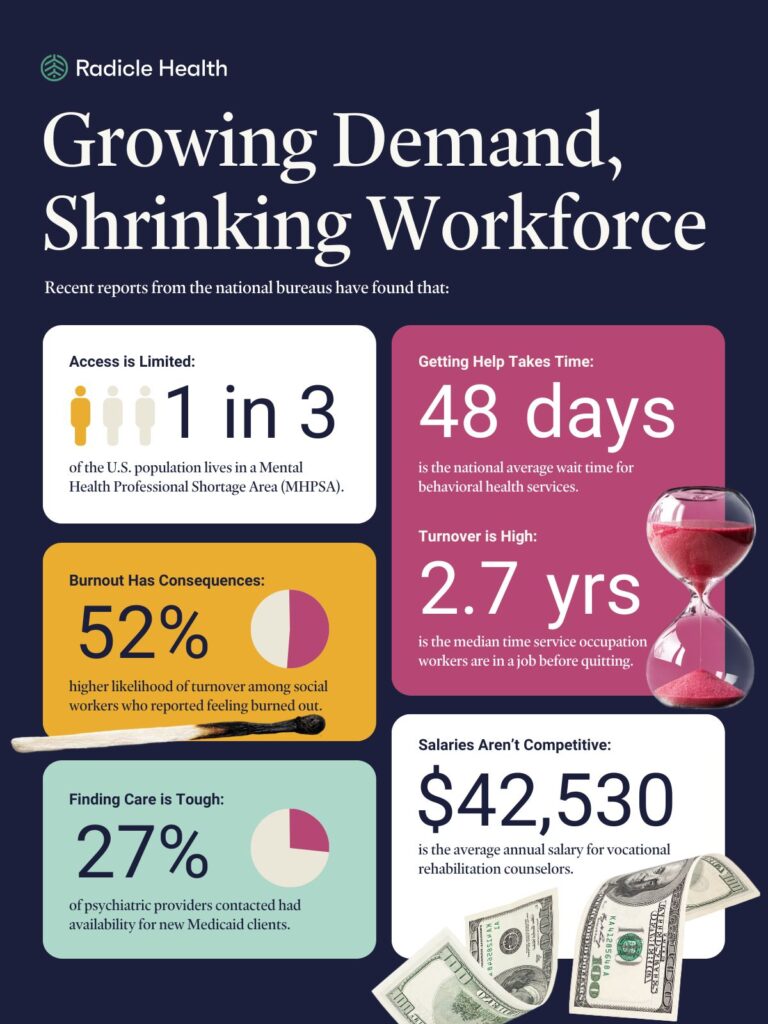From burnout and turnover to a better path forward for the workers serving our communities.
What does it mean to be a healthy, productive individual? Most would describe someone who is physically and mentally well, has safe and stable housing and transportation, is gainfully employed, and is reasonably self-sufficient. But not everyone starts with the same opportunities—and health and productivity can look different depending on a person’s circumstances.
That’s why the field of Human Services exists: to support individuals in times of need, to help build skills that promote mental and behavioral wellness, and to assist people in joining or rejoining the workforce so they can support themselves and their families with dignity.
The professionals trained to deliver these essential services are overburdened and underpaid. They face growing caseloads, outdated processes and fragmented systems—conditions that lead to burnout and high turnover.
The national human services workforce shortage is affecting every state, and its impact is especially severe in rural and underserved communities. It has pushed care accessibility and quality out of reach for many. But there are solutions to this workforce shortage crisis. In this post, we’ll explore the driving factors of the shortage and share some practical approaches to address the crisis both nationally and locally.
The Scope of the Workforce Shortage
The scale of the human services workforce shortage is alarming, with the 2024 State of the Behavioral Health Workforce report projecting a rapidly growing needs and services gap. Shortages across human services sectors are expected to increase dramatically by 2037.
At the same time, states and service providers are navigating significant shifts in federal policy.

Adjusting to the New Normal
Over the past decade, the need for human services has grown significantly. Rising rates of depression, anxiety, substance use disorder, and suicide have placed immense pressure on behavioral health systems. At the same time, economic shifts, changes in workforce participation, and increasing disability claims have driven demand for vocational rehabilitation and related support services.
Access to these vital services remains uneven. In rural and underserved areas, providers are in short supply, infrastructure is limited, and outcomes are often worse. While the need for support has intensified, the systems and staffing required to meet that need have not kept pace.
The result is a growing crisis in care. Individuals and families are waiting longer for services—or going without them altogether—while frontline professionals are stretched thin. This post explores how we got here, and what can be done to build a stronger, more sustainable human services workforce moving forward.

Contributing Factors to the Human Services Workforce Shortage Crisis
Low Reimbursement Rates, Funding, and Wages
Across behavioral health, mental health, and home and community-based services (HCBS), low reimbursement rates remain one of the biggest barriers to building and sustaining a strong workforce. Medicaid rates, in particular, often fall well below what private payers offer. As a result, many providers have opted out of insurance panels and require payment at the time of service. Faced with delayed or suboptimal compensation, some providers question whether entering these fields is worthwhile in the first place.
Opt-outs have created a further barrier to access: According to the 2023 National Survey on Drug Use and Health (NSDUH), 59.8% of adults aged 18 or older with any mental illness (AMI) who had a perceived unmet need for mental health treatment reported that they thought treatment would cost too much.
Federal funding is an issue that’s also changing service providers’ outlooks. The Congressional Budget Office estimates that recent Medicaid policy changes could lead to approximately 5.2 million individuals losing Medicaid coverage, dealing a catastrophic blow to both participants and the providers who serve large numbers of Medicaid clients. On the nutrition front, the Supplemental Nutrition Assistance Program (SNAP) faces cuts of nearly $300 billion through 2034.
Workforce Development programs often rely on funding tied to performance outcomes measured by the Workforce Innovation and Opportunity Act (WIOA), such as helping jobseekers find employment. But with staff vacancy rates consistently around 20%, achieving those outcomes becomes much more difficult. At the local workforce development board level, where much of the work is done to forge connections between participants and local employers, the size of their federal funding pool is determined by how much unused funding trickles down from the state.
And on the wages front, many human services professionals hold advanced degrees with hefty student loans attached, but struggle with living expenses due to low wages in the field. For example, vocational rehabilitation counselors who do the highly detailed work of helping people with disabilities navigate employment barriers earn an average annual salary of just $42,530.

Aging Workforce, Low Retention
The U.S. is currently in the midst of a “Peak 65” moment. Every day of 2024, more than 11,000 people turned 65, and the trend is expected to continue through 2027. The makeup of the workforce is already changing, with retirement outpacing recruitment efforts.
The U.S. Bureau of Labor Statistics projects that employment of social and human service assistants will grow by 8% from 2023 to 2033, faster than the average for all occupations. Approximately 48,400 openings are expected each year to replace retiring workers and those leaving their professions.
HCBS: Who’s There to Care for an Aging Population?
As our population ages, the need for HCBS services has never been greater. Yet the people providing this care—often forming close, trusted bonds with those they serve—are leaving the field at alarming rates. In 2023, the median turnover rate for professional caregivers in the home care industry climbed to 79.2%, according to the 2024 Activated Insights Benchmarking Report. That means for every ten caregivers who start the year, only two are likely to still be there at the end of it.
The reasons aren’t hard to see. With the U.S. Bureau of Labor Statistics reporting average wages for home health aides and similar roles at just $14.46 per hour, many caregivers struggle to make ends meet despite the physically and emotionally demanding nature of their work. For agencies, the cost of this turnover is staggering—replacing a single worker is estimated at $4,208, which adds up to more than $330,000 a year for an agency with 100 HCBS staff.
But the greatest cost is harder to measure: the disruption in care for older adults who depend on familiar, consistent faces. Each departure can mean a client loses someone who knows their routines, understands their health needs, and shares in the small moments that bring comfort and dignity to daily life. When that continuity is broken, it’s not just care plans that are interrupted—it’s relationships, trust, and stability.
As the Peak 65 wave continues, the question isn’t just how we recruit more HCBS workers—it’s how we make these roles sustainable and valued so caregivers can build careers in the work they love, and older adults can age with the consistent, compassionate care they deserve.
Rising Demand for Human Services
The demand for human services continues to rise despite its waning workforce. The COVID-19 pandemic intensified mental health and employment issues across all age groups, further straining already limited resources and systems of care. And the fallout and backlog from those years continues to impact our communities.
Access to behavioral health services remains challenging due to provider shortages, high out-of-pocket costs, coverage gaps, and other barriers. According to the U.S. Health Resources and Services Administration’s November 2024 report, the national average wait time for behavioral health services is 48 days. A separate 2024 study found that only 18% of psychiatrists accepting Medicaid were taking new patients, with some wait times for care exceeding six months.
And demand is highest on either end of the age spectrum: The 2024 HRSA Workforce Brief reports that adolescent treatment for major depressive episodes rose from 57% in 2022 to 60% in 2023. On the other end, the 65+ population will grow by 54% by 2060, resulting in a projected shortfall of 1,740 geriatricians by 2036.
On the nutrition front, food banks across the U.S. are experiencing unprecedented demand, exacerbated by the end of pandemic-era benefits and unabating food prices. In March 2025, the USDA paused $500 million in food-related programs, leading to the loss of over 1.4 million meals in regions like rural Virginia and the Washington area. These cuts have forced food banks to scramble for alternatives to meet growing demands.
Regulatory Barriers
Regulations are always a factor for human service agencies. Today, agencies need to adapt faster and utilize resources more nimbly than ever before. Here are just some of the changes in play:
- Federal Grant and Funding Disruptions (Jan 2025)
Impacted Sectors: Early childhood education, Medicaid/public health programs, social services, and DEI-related initiatives.
Human services programs that rely on federal grants, especially those connected to DEI efforts, faced uncertainty due to a temporary pause on funding. Although a federal judge stayed the order, the delay disrupted reimbursement for programs like Medicaid and Head Start, impacting service delivery to certain populations. - Reorganization of the Department of Health and Human Services (HHS) (Mar 2025)
Impacted Sectors: Healthcare, public health, behavioral health, and safety net services.
The reorganization of HHS, including the formation of the Administration for a Healthy America and workforce cuts, has disrupted operations across key service delivery areas. Providers and stakeholders have raised concerns about the continued availability of critical health and mental health services. - Regulatory Freeze and Policy Reversals (Jan 20, 2025)
Impacted Sectors: Social services, healthcare, education, and workforce development.
A federal regulatory freeze has stalled the implementation of pending policies impacting human services. Organizations in these sectors face increased compliance uncertainty as they await guidance on funding, eligibility, and operational rules. - Prior Authorization and Reimbursement Challenges
Impacted Sectors: Healthcare, behavioral health, and long-term care services.
Reforms to prior authorization and reimbursement procedures are creating transitional challenges for health service providers. While intended to reduce administrative burdens, these changes require organizations to quickly adapt to new compliance standards and systems. - Legislative Uncertainty Over WIOA Reauthorization
Impacted Sectors: Youth workforce development and after-school programs, vocational rehabilitation, workforce development for dislocated workers.
The reauthorization of the Workforce Innovation and Opportunity Act (WIOA) remained pending in Congress as of spring 2025. Delays in reauthorization create uncertainty for workforce development programs that rely on WIOA funding, affecting planning and service delivery.

Solutions
Improving Reimbursement Rates and Funding
To build and keep a strong human services workforce, we need to raise reimbursement rates, especially Medicaid and other publicly funded programs. One promising strategy is wage pass-through laws, which require a portion of increased provider payments to go directly to frontline workers. Some states have already seen success with this approach:
In 2024, Washington boosted Medicaid reimbursement rates by 15–20% and required MCOs to pass increases directly to behavioral health providers. New York followed suit mandating Medicaid-level rates from private insurers for behavioral health services (parity). In 2025, Connecticut approved $313 million to raise wages for nursing home and group home workers, with average pay increased to over $20/hour. These steps reflect a
growing commitment to long-term workforce sustainability, helping the helpers to first apply their own “oxygen masks.”
According to MACPAC, many states used American Rescue Plan Act (ARPA) funds to boost pay, offer hiring incentives, and introduce more competitive rate structures as temporary measures. Now, they’re racing to make those changes permanent by finding state dollars to replace expiring federal funds.
When federal funding is in jeopardy, braided funding is another financial strategy increasingly used across human service sectors. Here are a few examples:
- Early Childhood Services (e.g., Head Start, childcare subsidies): Combine federal funds (like CCDF), state education dollars, and philanthropic support to expand access and quality.
- Workforce Development and TANF: Leverage workforce grants, Temporary Assistance for Needy Families (TANF), and local economic development funds to provide job training and wraparound services.
- Healthcare and Behavioral Health: Coordinate Medicaid, SAMHSA grants, and local funding to integrate mental health and substance use services.
- Homelessness and Housing Stability: Align HUD funding with local housing authorities, health services, and private donations to deliver comprehensive housing supports.
This approach allows human service agencies to be more flexible and responsive to community needs, especially in times of federal funding uncertainty and program restructuring.
Improving the Human Services Workforce Pipeline
To build a more sustainable human services workforce, states are investing in training programs and career pathways that make the field more attractive across multiple sectors including behavioral and mental health, workforce development, and nutrition services. These initiatives create opportunities for workers to move into management roles or transition into related careers such as social work, counseling, and program administration.
States are also rolling out peer-mentoring and supportive supervision programs to strengthen on-the-job support, reduce isolation, and improve retention across the board.
Pipeline programs targeting high school and college students are another key strategy. These programs train students for jobs while helping them earn credits toward degrees or certifications. For example, Washington’s Medicaid agency partnered with the Office of Superintendent of Public Instruction to create a 90-hour training course for high school students that earns school credit and counts toward Home- and Community-Based Services (HCBS) worker certification.
The California Workforce Development Board is spearheading multiple initiatives and funding streams to expand access to training and support services. One standout is the new Wellness Coach role, launched under the Children and Youth Behavioral Health Initiative. Designed to meet the rising need for school-based mental health services, this role creates a pathway for candidates with associate or bachelor’s degrees and relevant fieldwork experience—accelerating entry into a field traditionally limited by high education barriers.
Similarly, nutrition-focused human services programs are working to grow their workforce by integrating job training with service delivery. Some states are expanding SNAP Employment & Training (SNAP E&T) partnerships with community colleges and workforce boards, helping food bank staff and nutrition educators move into higher-skilled roles while strengthening service capacity in underserved communities.
Innovations: Increasing Capacity, Reducing Burnout in Human Services
Telehealth continues to be a cornerstone in expanding access to care across human services sectors, particularly in rural and underserved areas. It not only reduces stigma (especially in seeking behavioral and mental health care) but also addresses barriers to access like provider shortages and transportation. While less than 1% of behavioral health outpatient visits were conducted via telehealth pre-pandemic, that number surged to 40% during early COVID-19 and remains high, with usage stabilizing around 25–30% nationally as of 2024.
Beyond behavioral health, telehealth is increasingly used in child welfare, substance use treatment, aging services, and disability supports to reach clients in more flexible and accessible ways. Integrated care models (combining physical, behavioral, and social supports) continue to gain traction, especially through Certified Community Behavioral Health Clinics (CCBHCs), school-based health centers, and family resource hubs.
Newer innovations, such as mobile care units, digital care navigation tools, remote patient monitoring, and AI-assisted intake and triage systems, are being tested to enhance efficiency and client engagement across service systems. These tools not only help overstretched staff manage caseloads but also create more personalized, timely, and culturally competent care pathways.
And though “AI” can still be an intimidating word for some in such highly human work, it is being leveraged to take on some of the most repetitive and burdensome tasks that human caseworkers do. AI can lessen burnout in human services by simplifying case note generation, mass communication, data collection, compliance documentation, and billing workflows tied to the most recent regulations and requirements.
As our country continues to face a historic human services workforce shortage crisis, leveraging telehealth and digital innovation is proving essential for bridging gaps in service delivery and safeguarding the future of care continuity and the wellness of overburdened care providers.
Conclusion
The human services workforce crisis is at a tipping point, but the situation is not without solutions. Staff shortages, low wages, and rising demand have strained every part of the system. But states are showing what’s possible through creative funding strategies, career pipelines, and innovation. To meet the moment, we need to focus on workers’ training opportunities and wages, and invest in integrated, tech-enabled care that increases access and reduces burnout. Human services professionals are the backbone of our communities and supporting them is the only path to a more equitable, resilient future for everyone.

Radicle Health Human Services Software: Here to Help
Radicle Health’s human services software solutions support over 14,000 organizations across the U.S. and Canada to streamline operations, reduce burnout, and strengthen their impact on the communities they serve.
Our EHR Solutions help organizations meet ever-evolving clinical and regulatory demands and simplify workflows so agencies can spend more time focused on clients. Whether you need support navigating value-based care or integrating data across programs, our platforms support the way your teams actually work.
Our Care & Outcomes solutions help agencies spend more time serving clients and less time on administrative work. We automate manual workflows, centralize the information you need, support integrated service delivery, and provide data tools to help you spot areas for continuous improvement. We help you improve outcomes and equity without increasing or overwhelming your staff.
Whether you’re redesigning care, adapting to new policies, or preparing for growth, Radicle Health brings people-first strategies, deep system knowledge, and hands-on support to help you succeed.
What challenges are you facing? Learn how Radicle Health can help.



